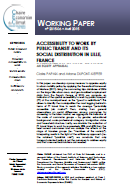
Optimal intertemporal abatement decisions under ambiguity aversion
by Simon Quemin
In a two-period partial-equilibrium model, this article characterises ambiguity averse firms’ optimal intertemporal abatement decisions in a cap-and-trade regime (ETS). Ambiguity aversion induces two effects that can be aligned or countervailing: (i) pessimism, which distorts firms’ subjective beliefs by overweighting bad scenarios and (ii) ambiguity prudence, which corresponds to an increase in firms’ discount factor. The direction and magnitude of these two effects depend on the degree of ambiguity aversion and initial allowance allocation, which is thus non neutral. Alternatively, firms are covered under a tax regime and only subject to ambiguity prudence. Under ambiguity aversion, both tax and ETS are not conducive to intertemporal cost-efficiency. We argue that ambiguity aversion on the part of firms can capture the influence of regulatory uncertainty on their abatement decisions and might contribute to observed recurrent patterns in existing ETSs: (1) there is a tendency towards allowance surplus formation when allowances are grandfathered, which is more pronounced under auctioning; (2) ambiguity prudence might support declining and low allowance prices.
KEYWORDS . Cap and Trade . Emissions Tax . Banking . Regulatory Uncertainty . Ambiguity Aversion . Pessimism . Ambiguity Prudence
